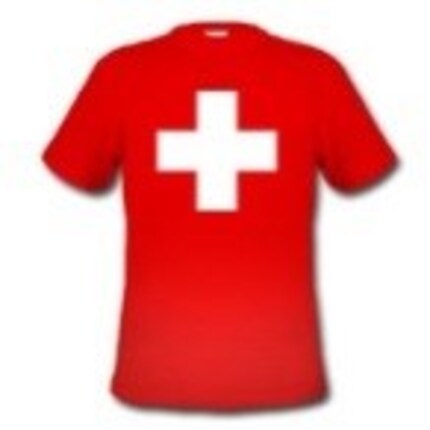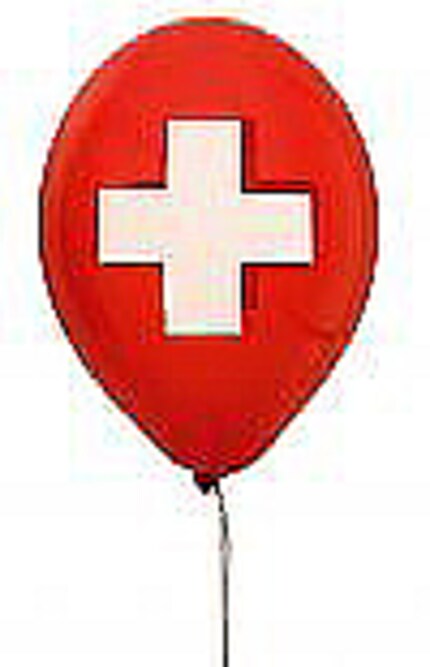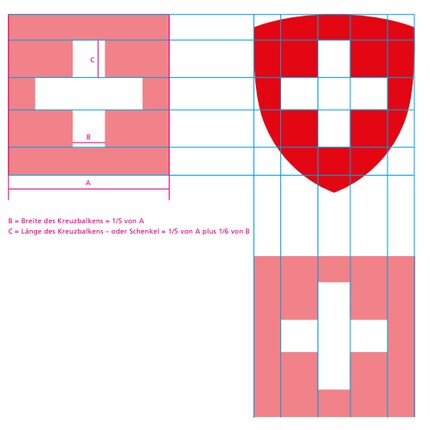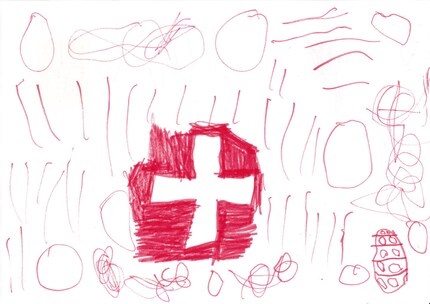Fighting the Swiss cross: Does OnePlus have to paste over its Plus?
The plus in the top right-hand corner of the OnePlus logo may look confusingly similar to a Swiss cross. Even after extensive research, it's impossible to say whether this is the case or not. Because the answer is always "In principle yes, but..."
"Look at that," I say to video producer Stephanie Tresch as she sets up the camera ready to shoot, "that's totally weird."
I'm looking at the specs of the new OnePlus 6T, which will be launched in a few weeks. Stephanie looks at me and says: "I'll just let the camera run."
"Fine by me. The thing is: OnePlus may, most likely, have to put a sticker on every box of the OnePlus 6T. But only in Switzerland."
"That's absurd," she says.
In principle, she's right. The whole farce surrounding the small cross seems absurd, but it is clearly regulated. So let's take a look at it.
The revenge of 1291
The logo on the packaging of a OnePlus 6T looks like this:

The problem:

This may go too far for the Swiss Federal Institute of Intellectual Property (IGE) and/or a plaintiff and/or a judge. Possibly. Because the situation is not that clear. OnePlus therefore has two options:
- Print the packaging differently for Switzerland
- Put an adhesive on each pack
The company's choice should be clear: glue.
But it goes without saying that the Chinese company does not do this itself. After all, if the seven million loners in Switzerland want adhesive on their mobile phone packaging, then they should provide it themselves.
The Swissness Act has been in force in Switzerland since 1 January 2017. The term "Swissness" refers to a series of legal requirements that stipulate the use of Swiss iconography. This was a more or less hotly debated topic in the press last year.
For example, the Swiss pot and pan manufacturer Kuhn Rikon had to spend 300,000 francs to ensure that its products and advertising materials complied with the new law.
This is now also affecting OnePlus, especially as it is not a traditional Swiss company whose "board of directors consists of Swiss nationals".
Radio Yerevan on the website
As a special bijou of absurd interpretations, the IPI website lists questions and answers on the topic of the use of Swiss iconography. The page entitled "Swiss cross and Swiss coat of arms" explains which products and services may and may not bear a Swiss cross. It is clear that if Switzerland is the country of production of the product or service, then there is no problem. But if it offends common decency, then there is.
But we in the digitec studio have to smile in particular at the following question:
Can the Swiss cross be used?
The answer brings back memories of "Radio Yerevan". The jokes about the fictional radio station in the Armenian capital at the time of communism and the Cold War always follow the same pattern. A fictitious listener asks an innocent question, such as "Can the Swiss cross be used?" and the politburo of Radio Yerevan responds with "In principle yes, but..." and "In principle no, but...".
This is also what happened at the IPI: In principle yes, but...
Yes.
The new law stipulates that the Swiss cross may not only be used for Swiss services - as was previously the case - but may now also be used on Swiss goods. In future, the most valuable origin mark in terms of marketing - the Swiss cross - may also be used commercially on products or on the packaging of products. The Swiss cross on a product or in connection with a service is generally regarded as a geographical reference to these products or services. The prerequisite for this is that the products fulfil the Swissness criteria.
If the Swiss cross is not perceived by consumers as an indication of the geographical origin of the product - for example, a red T-shirt with a large white cross as a motif, a red balloon with a white cross or a red umbrella with white crosses - this is a decorative use and the Swissness criteria do not have to be met.


Whether or not the Swiss cross is understood as an indication of source must be assessed on a case-by-case basis from the perspective of the intended public. The decisive factor is whether the Swiss cross specifically evokes certain expectations with regard to the geographical origin of the goods or services labelled with it.
In contrast, the Swiss coat of arms - i.e. the Swiss cross in a (coat of arms-like) shield - may only be used by the Swiss Confederation. However, there are exceptions to this ban.
The short version of whether just anyone can now use the Swiss cross:
- No, if the product does not serve national pride
- Yes, if junk has to be sold for the World Cup/EMs/1 August or any other occasion
- The IPI is not interested in room for interpretation. This lies with the viewer
- Only the Swiss Confederation may use the coat of arms
- There are exceptions for the coat of arms. Then people other than the Confederation may use it
But that's not enough for the IPI. The almost satirical catalogue of regulations goes even further. On the same page, the IPI defines what a Swiss cross looks like.
Are the colours and dimensions of the Swiss cross and the Swiss flag defined?
This comes from heraldry, because every flag in the world, at least the older ones, have an almost absurdly detailed description. But since the Swiss are internationally recognised as "Tüpflischiisser" extraordinaire, this doesn't even stop at the description of a simple cross.
Yes.
The Swiss cross is an upright, free-standing white cross in a red field, with equal arms that are one-sixth longer than they are wide. The exact dimensions of the Swiss flag and the size ratio between the cross and the square field are regulated in an annex to the law. The colour "red" of the flag is also defined. The definition corresponds to the information in the manual "Corporate Design of the Swiss Federal Administration", which is published by the Federal Chancellery (see website of the CD Federal Office). For practical reasons, the definition has been supplemented by other contemporary colour specifications that are frequently used.
Anybody who is authorised to use the Swiss cross may use it in this form or, as before, in a modified form. For example, the cross may be used in different proportions or in combination with other graphic elements. There is no obligation to use the Swiss cross only in this defined form.
Switzerland Tourism may therefore continue to use the Swiss cross in the form of an edelweiss.
The link to the "Federation corporate design" throws up an error 404 - page not found. Perhaps someone in Bern has realised that a nation state should at best use a better name than "Corporate Design". Or maybe not. You can quickly find a page via a full-text search, which spits out further definitions. The PDF on the page is currently in version 8.1 and defines "red" in chapter 1.4, among other things.

Source: admin.ch
Colour definition red according to the official corporate design of Switzerland
- CMYK 0 / 100 / 100 / 0
- Pantone 485 C / 485 U
- RGB 255 / 0 / 0
- Hexadecimal #FF0000
- Scotchcal 100-13
- RAL 3020 traffic red
Short: Your kids are drawing their patriotism wrong with their felt-tip pens and neocolour pens.

Source: Lucie Stevens, Alter: 5 Jahre
You can also take a look at the back of Lucie's drawing, by the way, because she leaves us another message.
The cross as a brand
However, if you own or have created a brand, you are allowed to use the Swiss cross as part of the design of your brand.
Can the Swiss cross be registered as part of a brand?
Simple question, but the answer again resembles a joke from the days of the Iron Curtain: "In principle, yes, but...":
Yes.
However, the Swiss cross is part of the public domain, which means it must be available to all market participants. It must therefore not be the only component of the brand. The Swiss cross must be combined with at least one other protectable word or figurative element for the brand as a whole to be eligible for protection and registration. This is referred to as a combined brand.
Since the Swiss cross must not be misleading as to the geographical origin, a brand with a Swiss cross can only be registered for Swiss goods and services. Further information on this can be found in our Guidelines in trade mark matters, Part 4, Section 8.6.
The Swiss Confederation and its companies can register the coat of arms as part of a brand.
[[quote:If a trade mark containing the Swiss cross as an element is filed for goods before the new law comes into force, it would have to be refused under the law still in force. However, if the depositor of this brand agrees that the date of deposit should be the date of entry into force of the new law, the application can be examined under the new law. The IPI will accept such applications from the date on which the Federal Council decides to bring the Coat of Arms Protection Act into force. Applications filed before this date will be assessed and rejected under the old law. "ige.ch"]]
Until about halfway through this Yerevan response, it all sounds quite okay for OnePlus, because the Chinese phone manufacturer's logo has other elements, is a different red (HEX #eb0028) and basically does everything right to be considered a "combined brand". Except that the phones come from China.
In other words: No Swiss cross for OnePlus. Or is there?
One sticker per pack?
A call to the IPI shows that the case is not quite so clear-cut after all. Because the thing is, according to the IPI: If the viewer expects there to be a Swiss product in the packaging and then pulls a Chinese one out of the pack, then there could be an infringement of trade mark law. But only if a potentially injured party sues. Incidentally, the potentially aggrieved party can do this wherever digitec sells in Switzerland. So everywhere.
In conclusion, however, this cannot simply be said. If OnePlus wanted to register as a brand, the company would have to manufacture the phones in Switzerland. Although it is more or less common knowledge that no smartphones are manufactured in Switzerland, there is still the possibility that someone could feel misled.
Even if a misled person then files a lawsuit, it is still not a given that OnePlus will be penalised. Because that is for a judge to decide at his own discretion. It is therefore quite possible that a woman from Bern Bethlehem will find that there should be a Swiss phone in the package, but the judge in Bern will say "Good woman, you are wrong", send her home and OnePlus will not suffer any damage.
But if OnePlus wants to be on the safe side and make sure that the woman from Bern Bethlehem can't get angry, then there's only one thing to do: glue. Or just another pack, because nothing in this story should have a clear outcome.
And because the matter is not yet complex enough, here's a little extra confusion: In theory, OnePlus could try to argue in the case of the woman from Bern Bethlehem that the sale of the Chinese phone in Switzerland, i.e. the service of sale, is a Swiss service. Therefore, the Swiss cross on the packaging, which may not be a Swiss cross at all, is justified. A judge would also have to decide on this.
What remains is us. Because in a few weeks, we'll be unpacking our OnePlus 6Ts. You probably before me, or almost at the same time. So here's a request: When you unpack your OnePlus 6T, why don't you quickly check whether there's a sticker over the logo and send me a photo of it.
Journalist. Author. Hacker. A storyteller searching for boundaries, secrets and taboos – putting the world to paper. Not because I can but because I can’t not.
Interesting facts about products, behind-the-scenes looks at manufacturers and deep-dives on interesting people.
Show all